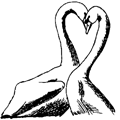Papers in the Biological Sciences

Handbook of Waterfowl Behavior by Paul A. Johnsgard
Date of this Version
January 1965
Document Type
Book Chapter
Abstract
The tribe of surface-feeding, or dabbling, ducks is the largest single tribe in the family. There are 40 species in the tribe as it is constituted here. Contrary to the arrangement of Delacour (1956), the ringed teal is included in the Cairinini; and the crested duck, included in the Tadornini by Delacour, is here considered a typical dabbling duck. In addition, the pink-headed duck has been removed from the Anatini and placed in the Aythyini with the pochards, and the freckled duck has been removed from the tribe and is considered a primitive species having anserine relationships. The marbled teal has been removed from the genus Anas and placed in a monotypic. genus which, I believe, provides an evolutionary link between the dabbling ducks and the pochards.
The Anatini are world-wide in distribution and include the most numerous and widespread species of the family. Most species (and especially those of the shoveler group) forage on the water surface, gathering food from the surface by up-ending or "tipping-up," or, more rarely, by diving. Most species open their wings when diving. A few species, such as the wigeon, graze, and nearly all species are predominantly vegetarians. Nearly all nest on the ground, but a few species nest in holes or crevices. The downy young are much like those of the perching ducks and are usually strongly marked with brown and white or with yellow. All species mature their first year, and pair bonds are generally renewed yearly. Most species exhibit sexual dimorphism in plumage, and metallic coloration is usually restricted to the head and speculum. The males of most sexually dimorphic species have a distinct eclipse plumage. Nearly all species have metallically colored wing specula. Males of all species studied to date except one have tracheal bullae which are ossified throughout; the marbled teal is the exception, and its bulla has numerous membranaceous fenestrae similar to those found in the pochard group.


Comments
From Handbook of Waterfowl Behavior by Paul A. Johnsgard. Copyright © 1965 Cornell University Press; electronic edition copyright © 2008 Paul A. Johnsgard.